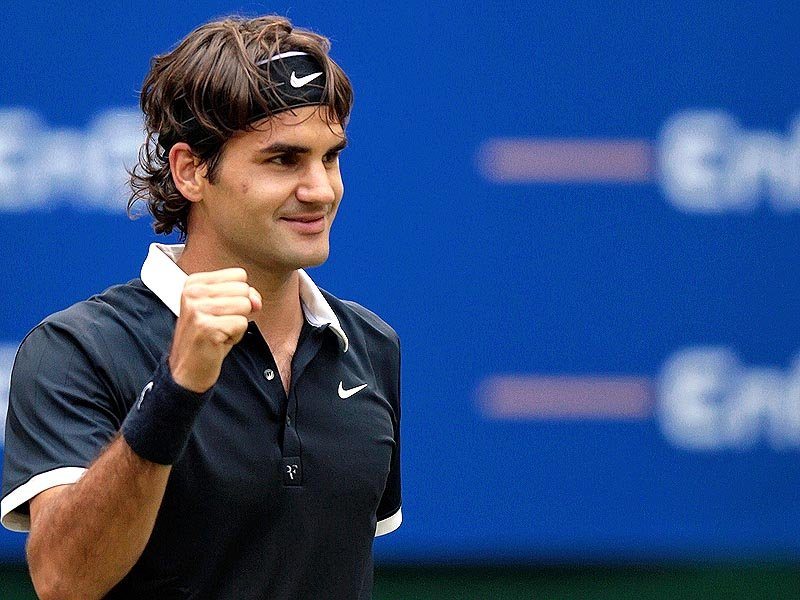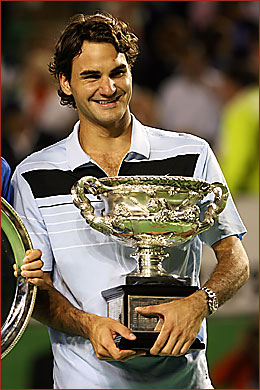o 1.1 Marriage and family
o 1.2 Outreach and charitable efforts
* 2 Tennis career
o 2.1 Pre-1998: Junior years
o 2.2 1998–2002: Early career in the ATP
o 2.3 2003–2006: Breakthrough and dominance
o 2.4 2007 to present: Becoming the greatest
o 2.5 Rivalries
+ 2.5.1 Federer vs. Nadal
+ 2.5.2 Federer vs. Hewitt
+ 2.5.3 Federer vs. Nalbandian
+ 2.5.4 Federer vs. Djokovic
+ 2.5.5 Federer vs. Murray
+ 2.5.6 Federer vs. Roddicko 2.6 Playing style
o 2.7 Equipment, apparel, endorsements
o 2.8 Grand Slam performance timeline
o 2.9 Year-End Championship performance timeline
o 2.10 Olympic games
o 2.11 Records
* 3 See also
* 4 References and notes
* 5 Further reading
* 6 Video
* 7 External linkso 7.1 Profiles
Federer was born in Binningen, near Basel, to Swiss national Robert Federer and South African-born Lynette.He holds both Swiss and South African citizenships. He grew up in suburban Münchenstein, near Basel, close to the French-German borders and Federer speaks Swiss German, German, French and English fluently.[ He was raised as a Roman Catholic and met Pope Benedict XVI while playing the 2006 Internazionali BNL d'Italia tournament in Rome.[20] Like all male Swiss citizens, Federer was subject to compulsory military service in the Swiss Armed Forces. However, in 2003 he was deemed unfit due to a long-standing back problem and was subsequently not required to fulfill his "obligations.Federer is married to former Women's Tennis Association player Mirka Vavrinec. They met while competing for Switzerland in the 2000 Sydney Olympics. Vavrinec retired from the tour in 2002 because of a foot injury and has since been working as Federer's public relations manager. They were married in Basel on 11 April 2009, surrounded by a small group of close friends and family at Wenkenhof Villa (municipality of Riehen).On 23 July 2009, Mirka gave birth to twin girls, Myla Rose and Charlene Riva.
Outreach and charitable effortsFederer supports his charities. He established the Roger Federer Foundation in 2003 to help disadvantaged people and to promote sports. In 2005, he auctioned his racquet from his US Open championship to aid victims of Hurricane Katrina. He was appointed a Goodwill Ambassador by UNICEF in 2006. At the 2005 Pacific Life Open in Indian Wells, Federer arranged an exhibition involving several top players from the ATP tour and WTA tour called Rally for Relief. The proceeds from the event went to the victims of the tsunami caused by the 2004 Indian Ocean earthquake . Since then, he has visited South Africa and Tamil Nadu, one of the areas in India most affected by the tsunami. He has also appeared in UNICEF public messages to raise public awareness of AIDS. In response to the 2010 Haiti earthquake, Federer responded by arranging a collaboration with fellow top tennis players Rafael Nadal, Novak Djokovic, Andy Roddick, Kim Clijsters, Serena Williams, Lleyton Hewitt and Sam Stosur to forgo their final day of preparation for the 2010 Australian Open to form a special charity event called Hit for Haiti, in which all proceeds will go to the Haiti earthquake victims. He was named as a 2010 Young Global Leader by the World Economic Forum in recognition of his leadership, accomplishments and contributions to societySimilar to the 2010 event, Hit for Haiti, Federer participated in a charity match called Rally for Relief on 16 January 2011, to benefit those that were affected in the 2010-2011 Queensland floods.
Pre-1998: Junior yearsMain article: Roger Federer juniors years
Federer's main accomplishment's as a junior player came at Wimbledon, where he won both the singles tournament over Irakli Labadze 6–4, 6–4 and in doubles teamed up with Olivier Rochus, in which they defeated the team of Michaël Llodra and Andy Ram 6–4, 6–4. In addition, Federer lost the US Open Junior tournament in 1998 to David Nalbandian in 3–6, 5–7. He won four other ITF junior singles tournaments in his career, including the prestigious Orange Bowl where he defeated Guillermo Coria 7–5, 6–3 in the finals. He ended 1998 as the junior World Number One.
1998–2002: Early career in the ATP
Main article: Roger Federer's early career
A dark-haired man in all white clothing, and caring a redish-black bag on his right shoulder and a black one on the left shoulderFederer at the 2002 US OpeRoger Federer's first tournament as a professional was Gstaad in 1998, which he faced Lucas Arnold Ker in the Round of 32, and he lost 4–6, 4–6. Federer's first final came at the Marseille Open, which was in 2000, and he lost to fellow Swiss Marc Rosset 6–2, 3–6, 6–7(5). Federer won in 2001 the Hopman Cup representing Switzerland, with Martina Hingis. Federer's first win was at the 2001 Milan Indoor tournament, which he defeated Julien Boutter by a score of 6–4, 6–7(7), 6–4. In 2001, Federer made his first Grand Slam quarterfinal at the French Open, and at Wimbledon that same year defeated four-time defending champion Pete Sampras to reach the quarterfinals. The most prestigious event final he reached during this period was the 2002 Miami Masters event, where he lost to Andre Agassi in 3–6, 3–6, 6–3, 4–6 on hardcourt. In addition, Federer won his first Master Series event at the 2002 Hamburg Masters on clay in 6–1, 6–3, 6–4 over Marat Safin; the victory made him a top-10 player for the first time.Federer made ten singles finals during this time in his career between 1998 and 2002, of which he won four and lost six From 1998 to 2002, Federer made six finals in doubles. Of note are Federer and partner Max Mirnyi's defeat in the final of the Indian Wells Masters in 2002, and their victory in the same year in the final of the Rotterdam 500 series event. Federer had won the latter the year earlier with partner Jonas Björkman. 2003–2006: Breakthrough and dominance
Main articles: Roger Federer in 2003, 2004, 2005, and 2006In 2003, Federer won his first Grand Slam singles title at Wimbledon, beating Mark Philippoussis 7–6(5), 6–2, 7–6(3)Federer won his first and only doubles Masters Series 1000 Event in Miami with Max Mirnyi,and made it to one singles Masters Series 1000 Event in Rome on clay, which he lost.Federer made it to nine finals on the ATP Tour and won seven of them, including the 500 series events at Dubai and Vienna. Lastly, Federer won the Year-End Championships over Andre Agassi.
During 2004, Federer won three Grand Slam singles titles for the first time in his career, and became the first person to do so since Mats Wilander in 1988. His first Grand Slam hard court title came at the Australian Open over Marat Safin 7–6(3), 6–4, 6–2. He then won his second Wimbledon crown over Andy Roddick 4–6, 7–5, 7–6(3), 6–4.[42] Federer defeated the 2001 US Open champion, Lleyton Hewitt, at the US Open for his first title there 6–0, 7–6(3), 6–0. Federer won three ATP Masters Series 1000 events. One was on clay in Hamburg, and the other two were on hard surfaces in Indian Wells and Canada. Federer took the ATP 500 series event at Dubai, and wrapped up the year by winning the year-ending championships for the second time.A dark-haired man is waving to the crowd with his tennis racket in his right hand, and he is wearing all white clothingFederer during the 2005 Wimbledon Championships, where he won his third consecutive title.In 2005, Federer failed to reach the finals of the first two Grand Slam tournaments, losing the Australian Open semifinal to eventual champion Safin and the French Open semifinal to champion Rafael Nadal. However, Federer quickly reestablished his dominance on grass, winning the Wimbledon Championships over Andy Roddick 6–2, 7–6(2), 6–4. At the US Open, Federer defeated Andre Agassi in the latter's last Grand Slam final 6–3, 2–6, 7–6(1), 6–1. Federer would also take four ATP Masters Series 1000 wins: Indian Wells, Miami, and Cincinnati (on hard court) and Hamburg (on clay). Furthermore, Federer won two ATP 500 series events at Rotterdam and Dubai. Federer lost the year-ending championships to David Nalbandian in the final.In 2006, Federer won three Grand Slam singles titles and reached the final of the other, with the only loss coming against Nadal in the French Open 1–6, 6–1, 6–4, 7–6(4). This was the two men's first meeting in a Grand Slam final. Federer defeated Nadal in the Wimbledon Championships final 6–0, 7–6(5), 6–7(2), 6–3, which was the start of their storied rivalry. In the Australian Open, Federer defeated Marcos Baghdatis 5–7, 7–5, 6–0, 6–2 and at the US Open, Federer defeated Roddick (2003 champion) 6–2, 4–6, 7–5, 6–1.[4 In addition, Federer made it to six ATP Masters Series 1000 finals, winning four on hard surfaces and losing two on clay to Nadal. Federer won one ATP 500 series event in Tokyo, and captured the year-end championships for the third time in his career.
 roger federer
roger federer roger federer
roger federer roger federer
roger federer roger federer
roger federer roger federer
roger federer roger federer
roger federer roger federer
roger federer roger federer
roger federer roger federer
roger federer roger federer
roger federer roger federer
roger federer roger federer
roger federer roger federer
roger federer roger federer
roger federer roger federer
roger federer roger federer
roger federer roger federer
roger federer


No comments:
Post a Comment